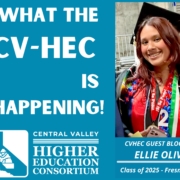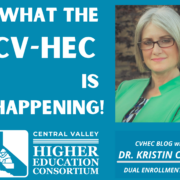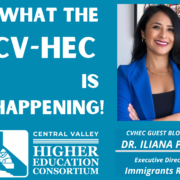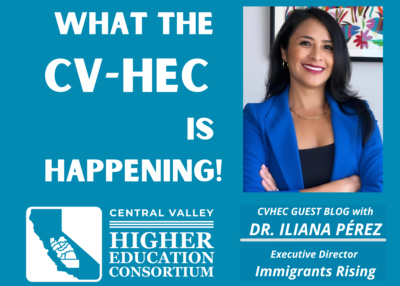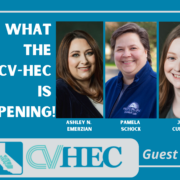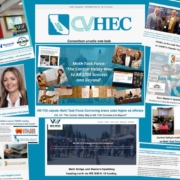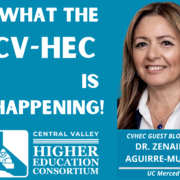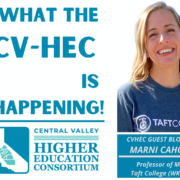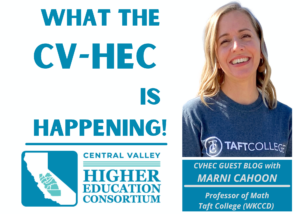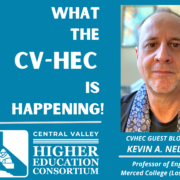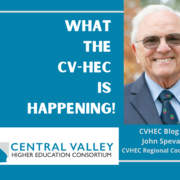‘What the CV-HEC is Happening’ Blog: Dr. Kristin Clark
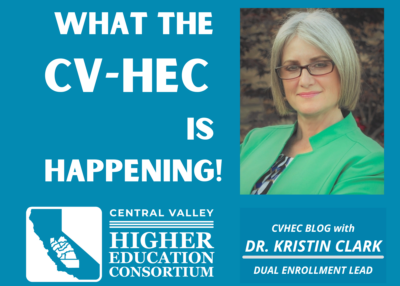 This edition of the “What the CV-HEC is Happening” Blog features Dr. Kristin Clark, chancellor-emeritus of the West Hills Community College District, who in March came out of short-lived retirement to join the CVHEC team as dual enrollment lead, announced in our March issue by Dr. Benjamín Durán, CVHEC executive director. Here Dr. Clark provides some insight into this bold move to throw down the retirement mantle and resume her “commitment to higher education, particularly in support of those who have been marginalized and underserved.” For more information about partnering with CVHEC’s dual enrollment team, contact us at CVHECinfo@mail.fresnostate.edu. (CVHEC blog submissions are welcome for consideration: Tom Uribes, cvheccommunications@mail.fresnostate.edu).
This edition of the “What the CV-HEC is Happening” Blog features Dr. Kristin Clark, chancellor-emeritus of the West Hills Community College District, who in March came out of short-lived retirement to join the CVHEC team as dual enrollment lead, announced in our March issue by Dr. Benjamín Durán, CVHEC executive director. Here Dr. Clark provides some insight into this bold move to throw down the retirement mantle and resume her “commitment to higher education, particularly in support of those who have been marginalized and underserved.” For more information about partnering with CVHEC’s dual enrollment team, contact us at CVHECinfo@mail.fresnostate.edu. (CVHEC blog submissions are welcome for consideration: Tom Uribes, cvheccommunications@mail.fresnostate.edu).
Retired, but not expired: a higher ed encore
BY DR. KRISTIN CLARK
CVHEC Dual Enrollment Lead
Chancellor-emeritus, West Hills Community College District
In August 2024, after 30 years in higher education, I made the difficult decision to retire so I could focus on traveling, spending more time with family and doing things I love — like flying and gardening. Some people said I was “too young to retire,” and although I retired earlier than most, my passion for education — and my belief that it is the gateway to freedom — will never wane.
My career has been driven by a deep commitment to expanding access to education, supporting student success and promoting economic opportunity in my community. Even in retirement, I was certain I would remain engaged in this important work in a meaningful way.
After a two-month adventure across Switzerland, France, Portugal and Spain with my husband, I’m eager to re-engage in the field I love. My commitment to higher education, particularly in support of those who have been marginalized and underserved, remains unwavering. I’ve always believed that education is the key to personal freedom — it gives people the power to shape their own futures rather than having circumstances dictate them.
More broadly, education is the cornerstone of our democracy — it empowers
individuals, strengthens communities and fuels economic mobility. As a first-generation college graduate who took a non-traditional path through education and my career, I understand first-hand both the transformative power of learning and the barriers many students face in achieving their goals.
The Central Valley’s unique challenges and strengths
In the Central Valley, these challenges are especially pronounced. Many students face financial insecurity, limited access to educational opportunities, family responsibilities and even basic logistical barriers like transportation. Just as I was fortunate to have mentors who guided and encouraged me, I believe we share a responsibility to ensure that every student has the support, resources and motivation they need to succeed.
One of the greatest strengths of the Central Valley’s higher education landscape is its collaborative leadership. The region’s college and university CEOs are some of the most innovative and student-centered leaders in the country. Over the past few months, I’ve missed the dynamic exchanges and strategic problem-solving that happen when visionary leaders come together to drive student success.
As a consortium, we’ve been laser-focused on student-centered strategies that lead to degree completion and upward economic mobility — goals that remain as critical as ever. And I still want to be involved.
The power of collaboration
In today’s increasingly complex and politically charged environment, higher education leaders face immense challenges in balancing a myriad of priorities while keeping students at the center.
That’s why collaboration is more important than ever. Organizations like the Central Valley Higher Education Consortium (CVHEC) play a vital role in supporting institutional leaders by providing research, resources, and a collaborative space to drive systemic change.
I believe that by working together, we can push the envelope to pursue bold and innovative initiatives that remove barriers for students, enhance economic development, and strengthen our workforce. I want to be part of innovative initiatives that produce real, measurable outcomes.
Taking action: expanding and supporting dual enrollment
One of my first projects in this new chapter is helping expand and support dual enrollment — a proven tool for improving college access and success. Research shows that dual enrollment increases college participation and success, and it provides students with the confidence and momentum to continue their education beyond high school.
With that in mind, I’m excited to join CVHEC as a core team member and work alongside Elaine Cash, CVHEC members, K-12 partners and other education leaders to develop a dual enrollment playbook. This resource will highlight best practices and provide much-needed guidance for our partners, helping to streamline pathways, address equity gaps and create more opportunities for students to get a head start on their college journey.
If you have ideas for this playbook, please reach out. Elaine and I are listening.
Looking ahead
The challenges ahead are significant, and as a recently retired administrator, I understand the competing demands and pressures that today’s higher education leaders face. That’s why I’m committed to playing a supporting role in regional projects — offering my experience, passion and insight to help our institutions and leaders navigate these challenges and create lasting change.
I care deeply about our region and believe that through collaboration, innovation and an unwavering commitment to student success, we can create a future where every learner can achieve their dreams.
I’m excited for what’s ahead and honored to be part of this work. Most of all, I’m thrilled to continue working with some of my favorite colleagues, Central Valley leaders, who share my passion for education and are dedicated to making a difference.
Let’s get to work! I hope to see many of you at the upcoming Higher Education Summit as well!
‘What the CV-HEC is Happening’ Blog: Immigrants Rising – undocumented students on campus
This edition of the “What the CV-HEC is Happening” Blog features Dr. Iliana Pérez, executive director of Immigrants Rising, a San Francisco-based nonprofit organization dedicated to advancing opportunities for undocumented communities. Founded in 2006, Immigrants Rising transforms individuals and fuels broader changes to help our nation edge closer to fulfilling its ideal as a land of opportunity and access for all. With resources and support, undocumented people are able to get an education, pursue careers and build a brighter future for themselves and their community. Dr. Pérez, who was raised in the Central Valley native (Turlock), is an alumna of CVHEC-member Fresno State Fresno State where she earned a BA in mathematics before attending Claremont University for her master’s in economics and her PhD in education policy, evaluation and reform. She and her organization have worked with several CVHEC-member campuses regarding issues related to undocumented students including an entrepreneurship incubator and pitch competition for undocumented students with a shark tank style competition planned at Fresno State later this semester. In this month’s blog, she shares her personal experience as an undocumented student who has reinvested herself in her community. She outlines gains and ongoing challenges in that landscape and resources regarding undocumented students available to institutions of higher education. CVHEC members interested in collaborating with Immigrants Rising for their undocumented students may contact Dr. Pérez at iliana@immigrantsrising.org. (Submissions are welcome for consideration: Tom Uribes, cvheccommunications@mail.fresnostate.edu).
Blazing a Trail: my journey as an undocumented student
and the path forward for higher education
BY DR. ILIANA PÉREZ
Executive Director, Immigrants Rising
Growing up undocumented in the United States, higher education often felt like an impossible dream. The barriers were daunting, and the path ahead was unclear. Yet, with resilience, the support of my family and community, and the guidance of dedicated educators, I navigated my way from being an undocumented student to ultimately becoming one of the first undocumented Ph.D.s in the nation.
Today, as the executive director of Immigrants Rising, I see both the incredible progress we have made and the challenges that still lie ahead for undocumented students in higher education. It is my pleasure to see many more undocumented students breaking barriers, knowing that our collective success is shaping a more inclusive and equitable future. It is your necessary presence that transforms higher education and your resilience that carves out a future where undocumented students are an integral part of higher education. Your dreams, contributions, and belonging will shape the future of education for generations to come.
A mentor once told me, “We can’t make big, bold changes by remaining the token person — we must push forward, bring others with us, and work toward systemic change.”
Many undocumented students on this journey today may be facing some critical questions: Do my contributions matter? Are my dreams valid? What legacy — what journey can there be for human beings like me with this uncertainty? Do I belong here? These are questions that loomed over me when I began my academic journey at Fresno State in 2005. Considerable progress has been made since then, but today, these questions resurface.
My academic journey was deeply shaped by my time at Fresno State, a proud member of Central Valley Higher Education Consortium. As an undergraduate, I experienced firsthand the power of a supportive institution — one that embraced students like me, who often had to carve our own paths when there were no clear policies and financial aid structures. Fortunately, I was able to secure a full-ride scholarship through the Smittcamp Family Honors College at Fresno State, which provided the financial stability I needed to focus on my studies. However, even with this scholarship, barriers remained. I was restricted from employment and paid career training opportunities and remained uncertain about my undocumented status. At the time, about 1,620 undocumented students enrolled in higher education faced significant hurdles: ineligibility for federal financial aid, limited access to scholarships, and the ever-present fear of being unable to continue our education due to policy changes beyond our control.
Despite these challenges, I found support in the form of mentors, allies, and advocacy efforts within Fresno State and beyond. AB 540, which allowed me to pay in-state tuition, was a lifeline that enabled me to pursue my education, but just as crucial were the people who believed in my potential. After graduating from Fresno State, I continued my academic journey, eventually earning a doctorate—a milestone that once seemed unattainable. My pursuit of higher education was fueled by a commitment to open doors for others, just as so many had done for me.
My experiences as an undocumented student have informed my work in advocacy, research, and policy, particularly in ensuring that our higher education institutions can effectively support undocumented students and prepare them for their careers. It is not enough for these students to be admitted; they must receive the resources and structures necessary to succeed in higher education and beyond.
Today, we have made significant strides in California to support undocumented students. We have expanded AB 540 and passed the California DREAM Act to make higher education more accessible to undocumented students. We’ve also passed legislation that enables undocumented professionals to get professional licenses — all opportunities that did not exist a decade ago. Many colleges and universities, including those within CVHEC, have established undocumented student resource centers, offering critical guidance on financial aid, mental health, and career pathways.
Yet, challenges remain. Federal inaction on immigration reform continues to leave undocumented students in a precarious situation, uncertain of their futures. The Deferred Action for Childhood Arrivals (DACA) program is no longer available to new applicants, and the program itself remains under threat, exacerbating the uncertainty faced by many students.
Today, It is estimated that there are about 86,805 undocumented students enrolled in higher education in California and each year about 14,000 undocumented high school students graduate who are ineligible to apply for DACA. Additionally, there has been a decline in enrollment into higher education, as many undocumented students face mounting financial barriers and concerns about their future. Access to internships, professional licensure, and postgraduate opportunities remains a major hurdle, limiting the career trajectories of countless talented individuals. Moreover, the mental and emotional toll of living with uncertainty weighs heavily on undocumented students, impacting their academic and personal well-being.
As I work with CVHEC and its member institutions, I am reminded daily of the critical role that higher education plays in shaping opportunities for students like me. Institutions must go beyond simply admitting us; they must ensure we thrive. This means expanding access to institutional aid, advocating for inclusive policies at the state and federal levels, and fostering an environment where undocumented students feel seen and supported. Colleges and universities must also actively engage in career development efforts, ensuring undocumented students can access paid experiential and research training and learn about entrepreneurship opportunities. By leveraging community partnerships and state resources, institutions can help bridge the gap between education and career success.
As we look to the future, it is imperative that we continue advocating for systemic changes that will allow undocumented students to thrive. Through collective action, institutional commitment, and policy advancements, we can ensure that higher education remains a powerful vehicle for social mobility and justice. At Immigrants Rising, we are dedicated to providing undocumented students with the knowledge, resources, and support they need to achieve their academic and career aspirations. By fostering a community of empowerment and opportunity, we continue to push for systemic change and a future where all students, regardless of immigration status, can thrive. I invite you to join us in this mission—whether through advocacy, mentorship, or supporting policies that create more inclusive opportunities. Together, we can make a transformative and tangible difference in the lives of undocumented students and ensure that higher education remains accessible to all.
So, to all the undocumented students navigating this journey today: You belong in higher education. Your dreams are valid, your contributions matter, and your presence is reshaping the landscape of academia for generations to come. The moment you step onto a college campus, you are building a legacy that challenges barriers and opens doors for those who follow. Your journey is powerful, and your success will inspire countless others to dream bigger and strive for more.
CVHEC members interested in collaborating with Immigrants Rising for their undocumented students may contact Dr. Pérez at iliana@immigrantsrising.org.
‘What the CV-HEC is Happening’ Blog: Stop Campus Hazing Act
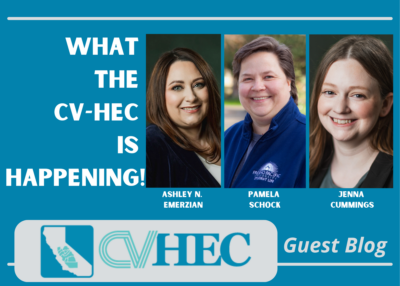 This edition of the “What the CV-HEC is Happening “ Blog for the Central Valley Higher Education Consortium February newsletter features Fresno attorney Ashley Emerzian of Emerzian Shankar Legal Inc. providing insights into the Stop Campus Hazing Act that was signed into law by President Biden in December, and the newly enhanced Clery Act that requires universities to include hazing data in their annual Clery Reports as well as publish a separate report which describes hazing violations. She reports that “staggering” statistics on higher education campus hazing have been widely reported in recent years and presents key areas of compliance that institutions of higher education will need to implement this year including deadlines and penalties such as loss of federal financial aid funding for Clery violations. She is joined in this blog by law partner Jenna Cummings and Pamela Schock of CVHEC-member Fresno Pacific University.
This edition of the “What the CV-HEC is Happening “ Blog for the Central Valley Higher Education Consortium February newsletter features Fresno attorney Ashley Emerzian of Emerzian Shankar Legal Inc. providing insights into the Stop Campus Hazing Act that was signed into law by President Biden in December, and the newly enhanced Clery Act that requires universities to include hazing data in their annual Clery Reports as well as publish a separate report which describes hazing violations. She reports that “staggering” statistics on higher education campus hazing have been widely reported in recent years and presents key areas of compliance that institutions of higher education will need to implement this year including deadlines and penalties such as loss of federal financial aid funding for Clery violations. She is joined in this blog by law partner Jenna Cummings and Pamela Schock of CVHEC-member Fresno Pacific University.
New year, new laws:
the Stop Campus Hazing Act is now in effect
By Ashley N. Emerzian, Esq. and Jenna Cummings, Esq.,
Emerzian Shankar Legal Inc.
and Pamela Schock, M.A., Assistant Dean of Student Development
Fresno Pacific University
In higher education, the number of laws and regulations impacting operations – everything from facilities to human resources and student affairs – is numerous and constantly changing. 2025 is trending towards more of the same.
One of the most recent new laws impacting the higher education sector is the new federal Stop Campus Hazing Act (“Act”). On December 11, 2024, the Senate passed the Stop Campus Hazing Act, which President Biden signed into law on December 24, 2024. The Act applies to all institutions of higher education in the United States that receive federal funding under Title IV.
Statistics on higher education campus hazing have been widely reported in recent years and are, in many ways, staggering. A prominent national study conducted in 2008 found that more than half of college students involved in a club, team, or other organization experience some form of campus hazing.[1] In athletics, the same study reported that 74% of students involved in varsity athletics programs experienced hazing.[2] This includes forced or coerced alcohol consumption, humiliation, isolation, sleep-deprivation, or sex acts – which were found by the study to be common across student groups, and across various types of higher education institutions.
Risks to higher education institutions of this behavior occurring on campus are also wide-ranging, including managing student harm and discipline resulting from the conduct, student attrition, negative press, and complex overlays with a variety of laws including Title IX, the Violence Against Women Act, and the Clery Act.
The newly enhanced Clery Act, which already required universities to collect and report data regarding crimes on or around campus, now requires universities to include hazing data in their annual Clery Reports. The Act also requires universities to publish a separate report which describes hazing violations. Key areas of compliance Universities will need to implement this year are addressed below.
Clery Report Requirement
Starting January 1, 2025, universities must collect data on hazing incidents reported to campus security or police, even if the incidents occur within student organizations that are not officially recognized by the university. Importantly, the Act defines a student organization as any organization that involves two or more members of the higher education institution. This presents unique jurisdictional considerations for universities to grapple with, particularly if they are typically used to enforcement of policies and procedures only for recognized organizations.
Additionally, universities must begin including this hazing data in their annual Clery Reports, starting with their 2025 Clery Report, which is due October 1, 2026. So, what is hazing?
The Act provides a comprehensive definition of hazing incidents which must be logged. The definition includes, but is not necessarily limited to, any “intentional, knowing, or reckless act” committed by one or more persons against another person, regardless of whether the victim participates willingly, that is part of an initiation or in affiliation with a student organization. Examples include causing, coercing, or otherwise inducing: whipping, beating, electric shock, placing harmful substances on one’s body; sleep deprivation, confinement in small spaces, extreme calisthenics; consumption of food, drug, alcohol or other substances; criminal acts; placing one in reasonable fear of bodily harm through threatening words or conduct; or sexual acts.
Publishing of Hazing Policies
Universities must begin publishing their hazing policies no later than June 24, 2025. These publications may be based on the university’s own definition of hazing instead of the act’s definition. However, deviations from the Acts definition should be considered carefully and in consultation with student affairs administration and legal counsel. The policies must include information on how to report hazing, how hazing is investigated, as well as state and local laws on hazing. The disclosure must also describe hazing prevention and awareness programs.
Campus Hazing Transparency Report
In addition to including hazing data in their annual Clery Report, institutions must begin publishing a separate report, called a Campus Hazing Transparency Report, by December 24, 2025. The report must include information about student organizations that have been found in violation of the institution’s hazing policy. Unlike the Clery Report, this report only needs to include information about recognized or established student organizations. The report must include specific details about the hazing violations, such as the names of the student organizations found responsible, descriptions of the violations, sanctions imposed, and whether alcohol and drugs were involved. Universities must exclude personally identifiable information of involved students from this report in order to comply with FERPA.
Universities’ first transparency report should include information dating back to July 1, 2025. Institutions must update the Report at least two (2) times a year with information regarding new hazing violations and keep each report publicly available on their website for five (5) years after publication.
Penalties
The Department of Education may impose civil monetary penalties for violations of the Clery Act where the institution is found to have “substantially misrepresented the number, location, or nature of the crimes required to be reported.” The current maximum penalty is $69,733 per violation; however, this maximum will be readjusted for inflation in 2025. Additionally, institutions can lose their federal financial aid funding for Clery violations.
As we look forward to 2025, it is recommended that universities begin coordinating their departments to begin implementation of these requirements, including the policy development work that will need to be completed this spring.
For more information, contact Ashley at aemerzian@eslegalinc.com
[1] National Study of Student Hazing, Hazing in View: Students at Risk, Dr. Elizabeth Allan and Dre. Mary Madden, 2006-2008.
[2] Id.
WHAT THE CV-HEC IS HAPPENING BLOG (Oct. 2024): Taft College dual enrollment
This month, the Central Valley Higher Education Consortium announces the return of our Central Valley Dual Enrollment for Equity and Prosperity (CVDEEP) Task Force Convening set for Nov. 14. So for our “What the CV-HEC is Happening” Blog this issue, we take a look at one member’s approach to dual enrollment at Taft College. Marni Cahoon, M.S., adjunct instructor of mathematics for the West Kern Community College District, recounts the road the Taft College faculty traveled to establish a program that helps its students face challenges on their academic journey with a renewed sense of hope and accomplishment. An alumna of University of Alaska, Southeast, Brigham Young University and the University of West Florida, Prof. Cahoon has been teaching at Taft since 2022.
Dual enrollment: overcoming
higher ed obstacles
‘… a force for opening college opportunities to more of our students’
BY MARNI CAHOON, M.S.
Adjunct Instructor of Mathematics (Taft College – West Kern Community College District)
During the 2022-2023 school year, I had the opportunity to teach the first dual enrollment mathematics course taught through Taft College on the campus of Taft Union High School in Taft, CA. Taft is a small tight-knit community on the southwest edge of the San Joaquin Valley, and about a 45-minute drive to Bakersfield.
Historically, Taft exists because of the presence of oil fields; indeed, many are still employed in this industry. As with much of the San Joaquin Valley, there is also a strong agricultural presence here.
Before embarking on my adventures at Taft High, I sought to understand the population I would be working with. At that time the latest data available was from the 2021-2022 school year. I found that Taft High serves a predominantly minority population with over 82% of students considered socioeconomically disadvantaged. Unfortunately, the latest test scores also showed that only 9% of Taft High students tested met or exceeded state standards in mathematics.
Economic disadvantages and low test scores combined with local industries not known for encouraging college education have perhaps left Taft High students less likely or seemingly unable to pursue higher education.
I see dual enrollment as vital to overcoming obstacles to higher education within my community. With the ability for students to enroll in and take higher education courses on their own high school campus, at no monetary cost to them or their families, I hope that dual enrollment is a force for opening college opportunities to more of our students.
This first dual enrollment math course was conceived with the desire to offer Calculus I to high school seniors, particularly those with an interest in entering the highly desirable STEM fields. Because the incoming senior class had spent a few of their high school years in the middle of the COVID-19 pandemic, a dual enrollment Precalculus course was offered as a prerequisite during the fall 2022 semester to ensure students would be prepared for the rigors of Calculus I in the spring.
My students came to me having had Algebra 2 and much of their high school’s Precalculus course online. As such, they had fought through much adversity to be eligible for Calculus I. Even so, the semester of dual enrollment Precalculus was invaluable in reviewing and reteaching concepts from algebra and trigonometry. I also saw this first semester as good exposure to the expectations of a college-level math course. By the time Calculus I came around that spring semester, my students understood that our course would move at a pace much quicker than a typical high school math class and were able to plan accordingly. They also were prepared for open-ended tests, and deeper dives into critical thinking. With these benefits, it was decided to continue teaching dual enrollment Precalculus before Calculus I in subsequent years.
As I have continued to teach dual enrollment throughout the semesters, I am always impressed with my students’ abilities to rise to the demands presented to them. Although many of my students have or will become the first in their families to attend college, they are determined to succeed.
Most importantly, my students are able to start a journey of essential self-discovery. Having successfully taken a rigorous college course undoubtedly gives these students confidence in their abilities to be successful college students. Indeed, as Calculus I is often considered a gateway to STEM careers, the ability to take the course before becoming traditional college students has allowed many of my students to narrow their academic focus and have a better understanding of the direction they would like their college education, and their future careers, to take.
Most of my students have gone on to enroll in engineering programs and Calculus II after high school graduation, with several attending Taft College. Others were able to decide before entering college full-time that a STEM degree wasn’t the best fit for them, thus allowing them to start their freshman year of college in a major better suited to their interests. So far, all of my students have started college after high school graduation.
Whichever path my students ultimately end up taking after leaving my class, the ability to take college-level math courses in high school will help them transition to life as college students. They are better able to rise above the demographics of their community and position themselves to take advantage of additional higher education opportunities.
WHAT THE CV-HEC IS HAPPENING BLOG (Sept. 2024): The college scene resumes
With the advent of the fall semester for our 28 member-institutions and for education throughout the nation, the Central Valley Higher Education Consortium presents a few words from Kevin A. Nelson, Merced College English professor who teaches at the Los Baños Campus, as the “What the CV-HEC is Happening” Blog for our September issue. An alumnus of California State University, Long Beach and Cal Poly Humboldt, Prof. Nelson has been teaching at Merced College since 2013. Here he offers some insights about his experience at the Los Baños Campus with words that capture the essence of college life across the nation as the fall semester is now in full swing.
‘Our goals are to succeed, to learn and understand
and to rise up and make life better’
BY KEVIN NELSON
Professor of English – Merced College Los Banos Campus
I have been teaching English at the Merced College Los Baños Campus since 2013: reading, writing, critical thinking and literature. I’d like to talk a little about why this campus is a good place to learn.
I attended Cal State Long Beach and Cal Poly Humboldt, and I lived and taught all over the world before coming to the Central Valley. My life experiences have been vastly different from the majority of my students and many of my peers, but somehow, we find common ground and form a community — a group of people who know each other and have common goals.
It is this little community of 15 to 35 people in my classrooms (and the people who support them every day) that makes the Los Baños Campus a great place to work and maybe, more importantly, a really great place to attend college.
My little community is diverse in and out of the classroom.
This year, we celebrate our math teacher’s 30th year of service at Los Baños Campus, and at the same time we welcome a new English instructor who was once a Merced College student!
One of my classes (a typical mix) has 16- and 17-year-olds who got to college faster than most of us, as well as returning students in their 30s and 40s and beyond. I get students who want to start a career, discover a new adventure, find a new path or embark on a second, third or fourth act!
I have students who struggled in K-12, students who excelled, students who struggle to keep up and students who zip through the work.
I have confident, shy, introverted, extroverted, older, and younger students. I have students who co-parent, students who help support their families financially, students with their own kids in college and students who are just starting families.
If you look around my classroom, you can get a glimpse of the community around the college.
My students are different from each other, but the same. Our similarity is in our goals and values. We value education, learning, collegiality — the opportunity to grow and be a stronger, more capable, more informed person. Our goals are to succeed, to learn and understand and to rise up and make life better.
For my little community, the goal is significant — every one of my students wants to be better at something. They have life and work goals, and they recognize that this is where better begins.
For me, community isn’t just about finding like-minded people, it’s about action — doing. This is why I live here and do this. I hope you will join us.
WHAT THE CV-HEC IS HAPPENING BLOG (Summer 2024): Why some colleges are worth it
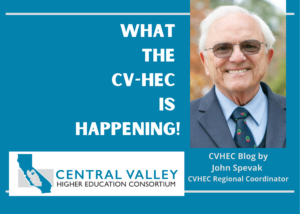 In the “What the CV-HEC is Happening” Blog for our summer 2024 special edition, Dr. John Spevak presents an observation about the value of a higher education. Dr. Spevak, who is a vice president-emeritus of Merced College and currently a regional coordinator for CVHEC, coordinates the English and Math Task Forces for the consortium — all champions for student support through such measures as dual enrollment. Through the consortium task forces, the former English teacher and college administrator continues to work closely with educators in the field for the educational advancement of students.
In the “What the CV-HEC is Happening” Blog for our summer 2024 special edition, Dr. John Spevak presents an observation about the value of a higher education. Dr. Spevak, who is a vice president-emeritus of Merced College and currently a regional coordinator for CVHEC, coordinates the English and Math Task Forces for the consortium — all champions for student support through such measures as dual enrollment. Through the consortium task forces, the former English teacher and college administrator continues to work closely with educators in the field for the educational advancement of students.
Higher ed is still a good
investment … and attainable
BY DR. JOHN SPEVAK
CVHEC Regional Coordinator
Vice President-Emeritus – Merced College
According to the results of a recent poll by Gallup and the Lumina Foundation, Americans are losing faith in the value of a college education.
Overall, according to that poll as reported by the Associated Press, only 36 percent of adults say they have a “great deal” or “quite a lot” of confidence in higher education. What’s worse, the poll shows that 32 percent of Americans have little or no confidence in a college education.
That’s both misleading and misguided.
For one thing “college” can mean different things to different people. For another, having a degree from the right college can make a big difference in a person’s opportunity and income.
By “right college,” I don’t mean a prestigious private college. A right college often means, especially in California, a two-year community college, a state university, or a small private college which provides significant financial aid.
A two-year community college degree or a certificate of completion is indeed “college.” That degree or certificate can be very valuable, especially if it’s a career-technical program that’s in demand and pays well, like nursing or welding.
A four-year degree can be even more valuable, especially in fields like communications, business, health, information technology and engineering– to name a few. Their lifetime earnings are significantly higher than those with a degree.
As the Associated Press article pointed out, “For those who forgo college, it often means lower lifetime earnings, 75 percent less compared with those who get bachelor’s degrees, according to Georgetown University’s Center on Education and the Workforce. And during an economic downturn, those without degrees are more likely to lose jobs.”
One of the reasons many Americans are doubting the worth of a college education is the debt often incurred in getting one. As one person interviewed in the AP article put it, “You graduate out of college, you’re up to eyeballs in debt, you can’t get a job, then you can’t pay it off.
What’s the point?”
It’s true that many people over the past decades have incurred a significant debt from student loans, which is exacerbated by the exorbitant interest charged for these loans. I know several people who have long ago paid off the principal of their student loans but are still paying and paying the interest.
However — and this had to be noted, known and understood — a person today can get a college degree without going into significant debt. The cost, for example, of attending a California community college these days in terms of tuition (also known as enrollment fees) is often zero.
Many California community colleges are also working at reducing the cost of books by providing what’s called “open educational resources,” essentially free online textbooks, often created by the college’s faculty members.
Attending a California public university or small private college can also be financially available to most Californians, especially if they begin with a two-year associates transfer degree and then follow a plan of courses that get them to the bachelor’s degree in no more than two additional years.
I’m tired of so many Americans of all backgrounds thinking of “college” as only prestigious private institutions that charge $150,000 or much more for a four-year tuition. Those universities often have value for those who can afford it or who receive full scholarships. But the vast majority of people can’t afford that amount and can’t afford to take out loans to pay for it.
“College” for most people should not be an expensive private institution. If it were, I would also wonder if a college education was worth it. However, “college,” in California and especially in the Central Valley, is accessible, affordable and worth it.
Instead of young people (and their parents) asking, “Can I afford college,” I wish they would ask, “What are my college options? What are the real costs, not just according to pundits on TV or social media, but according to the colleges themselves.”
College personnel, more than ever, are ready and willing to talk with prospective students of all ages and the parents of younger students about the real cost of a college education. And they are also ready and willing to show prospective students the extensive personal help they will receive to succeed in courses and earn their degree.
Often television and social media pundits who say college is not worth it are people who themselves have benefited from a college education. There’s some hypocrisy in that.
It’s true that there are many hard-working Americans without a college degree who can support themselves and their families, but the odds of most people doing this are long.
In California’s Central Valley, where the median family income is below the national average, it’s especially important to dispel the myth that college is not worth it. A two-year or four-year college degree is one of the best ways to achieve an income that will sustain families — enable them to pay rent or a mortgage, purchase a reliable car, buy clothes and put food on the table.
Central Valley colleges from Stockton to Bakersfield are working harder than ever to show students the value of a college education and to streamline the paths to a degree.
Community colleges in the valley, for example, are offering more dual enrollment courses than ever where students can earn college credits in high school, which reduces their time to a college degree.
These dual enrollment courses can be taken by most high school students, not just those students who in the past were steered into advanced placement (AP) courses. Community colleges are also working harder than ever, in collaboration with their high school partners, to provide the academic support needed to successfully complete dual enrollment courses.
In addition, many Central Valley community colleges, including Merced College, are partnering with the University of California Merced and local California State University campuses to provide user-friendly guides or “maps” to students and their parents. “Pathways Program Mapper” is a tool these colleges have developed that is available to anyone with a cell phone (no login or password required).
PPM will show a student what degree is needed to enter a particular career (for example, biology, business, engineering, etc.), what range of salaries people in those careers earn and then provide a map of courses from the first semester at a community college to the last semester at a university to attain that degree in the shortest possible time.
So, please, pundits, stop telling people that a college education isn’t worth it. Moreover, I hope readers of this column spread the word that here in the Central Valley a college education is not only worth it, but it’s attainable for anyone willing to pursue it.
John Spevak’s email is john.spevak@gmail.com.
WHAT THE CV-HEC IS HAPPENING BLOG (May 2024): Bienestar and Mental Healthcare
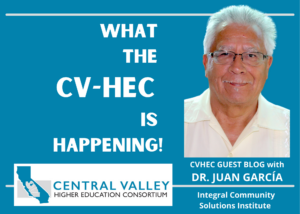 As Mental Health Awareness Month winds down — and keeping in the theme of our special medical education issue — our CVHEC “What the CV-HEC is Happening” blog this month presents a community voice discussing how CVHEC members are participating in a unique project that promotes mental healthcare for Latinx families and how mental illness, like other diseases, can be managed: the Bienestar Wellness Early Intervention Program. Juan C. Garcia, PhD., executive director of the Integral Community Solutions Institute (Community Counseling Services), presents how a two-year $2 million grant from the California Youth Behavioral Health Initiative Round 5 will help reduce barriers in obtaining medical health care; provide a culturally congruent introduction to mental health care in the Central Valley; and provide unique medical education opportunities on partnership with UCSF Fresno and Fresno State. Dr. Garcia is a licensed family therapist, a professor-emeritus of Fresno State’s Marriage and Family Therapy program, and a member of the Latino Mental Health Concilio. He co-founded ICSI in 2011 to provide counseling services to the unserved, underserved and the inappropriately served populations in the Central Valley by promoting community health through advocacy and wellness of the body, mind and spirit.
As Mental Health Awareness Month winds down — and keeping in the theme of our special medical education issue — our CVHEC “What the CV-HEC is Happening” blog this month presents a community voice discussing how CVHEC members are participating in a unique project that promotes mental healthcare for Latinx families and how mental illness, like other diseases, can be managed: the Bienestar Wellness Early Intervention Program. Juan C. Garcia, PhD., executive director of the Integral Community Solutions Institute (Community Counseling Services), presents how a two-year $2 million grant from the California Youth Behavioral Health Initiative Round 5 will help reduce barriers in obtaining medical health care; provide a culturally congruent introduction to mental health care in the Central Valley; and provide unique medical education opportunities on partnership with UCSF Fresno and Fresno State. Dr. Garcia is a licensed family therapist, a professor-emeritus of Fresno State’s Marriage and Family Therapy program, and a member of the Latino Mental Health Concilio. He co-founded ICSI in 2011 to provide counseling services to the unserved, underserved and the inappropriately served populations in the Central Valley by promoting community health through advocacy and wellness of the body, mind and spirit.
Mental Health Awareness Month:
early psychosis in Latinx families
Bienestar Wellness Early Intervention Program for mental healthcare
services to Latino and underserved communities includes CVHEC members
BY JUAN C. GARCIA, PhD.
Executive Director — Integral Community Solutions Institute
Stigma is an overwhelming concern when seeking mental health services in any community. In the Latinx community it is even more of a barrier to services.
Early psychosis in Latinx families is a devastating psychological breakdown of a family member. In the past, Latino families did not know that their child had treatment options.
However, Latinx families can be educated to understand that mental illness is a disease like other diseases and that it can be managed. If they wait too long to receive services for themselves or for their children, the mental illness may become so severe that it would be difficult to manage in the coming years. The earlier they receive services the better for everyone. Prevention education of Latinx families using cultural strategies reduces the long-term severity of this chronic mental health condition.
It is to this end that our community-based, non-profit organization, the Integral Community Solutions Institute (publicly known as Community Counseling Services), has secured funding for the Bienestar Wellness Early Intervention Program to reduce those barriers and provide a culturally congruent introduction to mental health care in the Central Valley.
 We are excited to gain the support of the University of California San Francisco-Fresno psychiatry residency program as well as support from Fresno State. Both are members of the Central Valley Higher Education Consortium which is made up of 28 institutions of higher education in its ten-county region.
We are excited to gain the support of the University of California San Francisco-Fresno psychiatry residency program as well as support from Fresno State. Both are members of the Central Valley Higher Education Consortium which is made up of 28 institutions of higher education in its ten-county region.
We hope that soon the news will spread to the rest of the community that you don’t have to suffer to receive mental health services. We at ICSI believe in promoting community health through advocacy and wellness of the body, mind and spirit.
The need: services provided inappropriately may trigger more emotional and psychological damage
In California, based on 2019 data, almost four percent of adults were diagnosed with a serious mental illness (SMI) and 7.3 percent of children were diagnosed with severe emotional disorders. In the San Joaquin Valley the incidence rate was 4.8 for adults and 7.8 for children, both slightly higher than the state.
When taking into consideration the federal poverty line, the INCIDENCE rate increases to 8.5 percent for adults with SMI and 10 percent for children with severe emotional disturbance. For the Latinx population, the incidence rate was 4.1 percent for adults and 7.8 percent for children with severe emotional disturbance.
As you probably can surmise, there may be several barriers to mental health access. Some of them are structural such as distance, location and times services are available. Even in the schools the sparse counseling available is limited to the school hours of operation. Critical services are not available in rural areas such as may be needed by someone having a psychotic break in an emergency in Mendota or San Joaquin. To get to services takes time, transportation and availability.
Once you do get to services though, there are another set of problems. If the services are not provided in a language you can understand, that creates lack of access.
There are many indigenous dialects being spoken in the San Joaquin Valley that originate in Mexico and Central America. The cultural clashes are inevitable and the mental health issues ensuing shortly after may become insurmountable without appropriate help. The mental health provider may use interpreters, but many mental health concepts are not translatable creating a cultural and linguistic gap in services. As such, services are provided inappropriately and could trigger more emotional and psychological damage.
Like language, culture has a grammar, structure, and process for effective communication. The use of familiar phrases based on mutually interpretable cultural understanding is imminent in these critical cases. The use of dichos, cuentos, canciones and other cultural understanding components facilitated by familiar symbols and linguistic devices provides the framework for trust, care and healing.
If I see a picture of George Washington cutting the cherry tree in the lobby of a mental health clinic, it does not help me if I am a Latinx client. If I see the symbol of La Virgen de Guadalupe on the wall or even the Aztec Calendar, I can feel assured that someone here understands me.
Culturally responsive or congruent services are needed to reach the client in language and cultural terms that make sense.
Once Latinx families are informed about what mental illness is, the red flags, and that the symptoms are treatable whether through therapy or medication, Latino families and individuals will feel less concerned about stigma. Families need to know that the sooner they can get their loved adolescent or young adult to mental health services the better the outcome. Psychotic symptoms if untreated for more than 18 months makes it more chronic and the individual may be unable to recover their full functioning in their lifetime.
And who is going to attend to these needs?
San Joaquin Valley’s number of practicing psychiatrists is lower than any other region in California including the coast, Los Angeles, San Diego and Sacramento at 6.2 per 100,000, which is nearly half compared to other regions. (See California Health Care Foundation Quick Almanac 2022 ).
We are heartened that, in recent years, the medical education movement in the Central Valley has picked up steam. We applaud leaders at all levels who are making this happen, and especially those who were central in helping us secure our two-year $2 million grant from the California Youth Behavioral Health Initiative Round 5. The project implements a strategy of the Coordinated Specialty Care (CSC) First Episode of Psychosis Program. UC Davis Department of Psychiatry will provide technical support for this project.
In addition to providing services to our community, the ICSI Bienestar project hopes to provide unique educational and training opportunities for programs in the Central Valley including the UCSF Fresno Psychiatry Residency Program and two Fresno State programs: the Rehabilitation Counseling Department and the Department of Social work.
Our goal would be for these training practitioners to be introduced to individuals and their families, and provide treatment via medication and therapy. Importantly, we hope to guide residents and trainees in getting to know the Latinx community, learning to provide culturally competent services and perhaps develop a long-term relationship for care.
One of the current psychiatry residents, Dr. Cecilia Rangel-Garcia, grew up in the Central Valley and plans to practice in the area. An alumna of UC San Diego (Medical Doctor and Master’s in Public Health degrees), she works closely with her residency supervisor, Dr. Karen Kraus, professor of psychiatry in the UCSF Dept of Psychiatry, to finalize a collaborative relationship for this project. (Disclosure: Dr. Rangel-Garcia also is the daughter of the author and Josie Rangel, LCSW, so she is very familiar not only with the professional medical aspects but also cultural and familial aspects).
Enriched training for the Central Valley
“Training in a specific community, working with an organization that is committed to this specific population which makes up a significant portion of the residents, is crucial in training,” says Dr. Rangel-Garcia. “By working with an organization like ICSI, our training will be enriched and we would be able to take and apply the lessons learned wherever we practice in the future. For me, that is the Central Valley.”
The trainee interns from the Rehabilitation Counseling Department and Department of Social Work, who stay with us for 9 – 12 months, are mentored to see clients under the supervision of ICSI’s licensed professionals with weekly meetings to review their cases. They receive training in multicultural aspects of counseling, counseling skills, hypnosis, ACT, DBT, family structural therapy and Integral psychotherapy. ICSI also accepts internships from other universities such as Alliant.
Together through the Bienestar Wellness Early Intervention Program, we can implement cultural strategies to make a connection with the client and communicate with him/her/she/them thus providing a framework for mutual understanding that facilitates the trust, safety and therapeutic alliance process needed while helping train more healthcare professionals to tackle these shortages we face here in the Central Valley.

